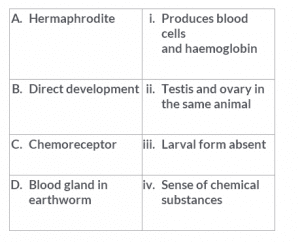NEET Exam > NEET Tests > Test: Earthworm - 1 (Old NCERT) - NEET MCQ
Test: Earthworm - 1 (Old NCERT) - NEET MCQ
Test Description
10 Questions MCQ Test - Test: Earthworm - 1 (Old NCERT)
Test: Earthworm - 1 (Old NCERT) for NEET 2025 is part of NEET preparation. The Test: Earthworm - 1 (Old NCERT) questions and answers have been prepared
according to the NEET exam syllabus.The Test: Earthworm - 1 (Old NCERT) MCQs are made for NEET 2025 Exam.
Find important definitions, questions, notes, meanings, examples, exercises, MCQs and online tests for Test: Earthworm - 1 (Old NCERT) below.
Solutions of Test: Earthworm - 1 (Old NCERT) questions in English are available as part of our course for NEET & Test: Earthworm - 1 (Old NCERT) solutions in
Hindi for NEET course.
Download more important topics, notes, lectures and mock test series for NEET Exam by signing up for free. Attempt Test: Earthworm - 1 (Old NCERT) | 10 questions in 10 minutes | Mock test for NEET preparation | Free important questions MCQ to study for NEET Exam | Download free PDF with solutions
Test: Earthworm - 1 (Old NCERT) - Question 1
The body of earthworm is divided into how many similar segments which are called metameres or somites?
Detailed Solution for Test: Earthworm - 1 (Old NCERT) - Question 1
Test: Earthworm - 1 (Old NCERT) - Question 2
In which segment in earthworm is the clitellum present?
Detailed Solution for Test: Earthworm - 1 (Old NCERT) - Question 2
Test: Earthworm - 1 (Old NCERT) - Question 3
In which one of the following organisms, is its excretory organs correctly stated?
Detailed Solution for Test: Earthworm - 1 (Old NCERT) - Question 3
Detailed Solution for Test: Earthworm - 1 (Old NCERT) - Question 4
Test: Earthworm - 1 (Old NCERT) - Question 5
Match the following and choose the correct answer.

Detailed Solution for Test: Earthworm - 1 (Old NCERT) - Question 5
Detailed Solution for Test: Earthworm - 1 (Old NCERT) - Question 6
Detailed Solution for Test: Earthworm - 1 (Old NCERT) - Question 7
Detailed Solution for Test: Earthworm - 1 (Old NCERT) - Question 8
Test: Earthworm - 1 (Old NCERT) - Question 9
Earthworms have no skeleton, but during burrowing, the anterior end becomes turgid and acts as a hydraulic skeleton. This is due to
Detailed Solution for Test: Earthworm - 1 (Old NCERT) - Question 9
Test: Earthworm - 1 (Old NCERT) - Question 10
If a live earthworm is pricked with a needle on its outer surface without damaging its gut, then the fluid which comes out is
Detailed Solution for Test: Earthworm - 1 (Old NCERT) - Question 10
Information about Test: Earthworm - 1 (Old NCERT) Page
In this test you can find the Exam questions for Test: Earthworm - 1 (Old NCERT) solved & explained in the simplest way possible.
Besides giving Questions and answers for Test: Earthworm - 1 (Old NCERT), EduRev gives you an ample number of Online tests for practice
Download as PDF



















